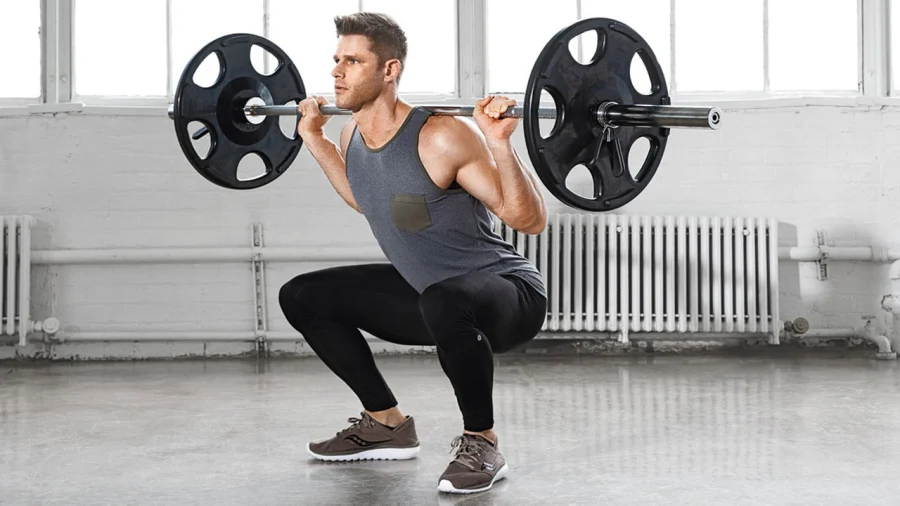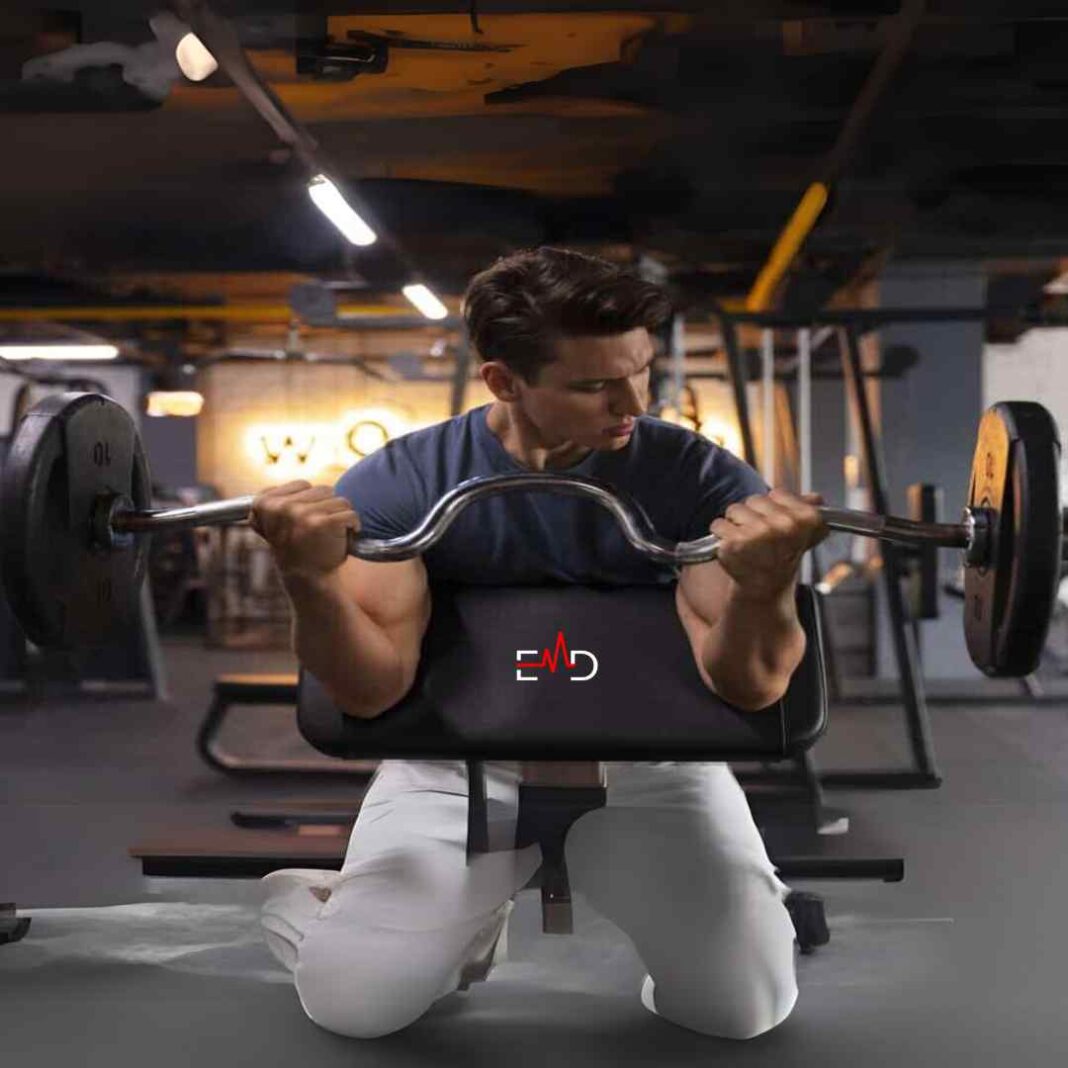Exercise Daily – Strength training is a fantastic way to improve overall fitness, boost metabolism, and develop a strong, toned physique. For beginners, it’s essential to understand the basics of weight training to set a solid foundation. Let’s see the Beginner’s Guide to Starting Strength Training to embark on your strength training journey. Mark Rippetoe’s basic barbell training principles are a great starting point, focusing on key exercises like the squat and the deadlift.
These compound movements are crucial for building overall strength. Incorporating exercises such as the power clean and Pendlay row will enhance your pulling movements and overall powerlifting performance. Personal trainers and resources from the National Strength and Conditioning Association can offer valuable guidance to ensure your training routine is effective and safe.
Starting Strength Training
Starting strength training is a methodical approach to building strength and gaining muscle mass. It revolves around the idea of using basic barbell lifts to stimulate the body’s natural adaptation process. The starting strength program, popularized by renowned strength coach Mark Rippetoe, is designed specifically for beginners looking to get stronger and fitter. By following this program, you’ll start with relatively light weights and incrementally increase the weight as you progress.

Basics of Strength Training
The Benefits of Strength Training
Strength training offers a wide range of benefits beyond just building muscle. It helps increase bone density, improves joint stability, enhances athletic performance, and promotes fat loss. Additionally, strength training boosts your metabolism, allowing you to burn calories even when you’re at rest. Whether you’re a beginner or an experienced lifter, incorporating strength training into your fitness routine can profoundly impact your overall health and well-being.
The Starting Strength System
The Starting Strength system is a comprehensive strength training program focusing on compound barbell exercises. It prioritizes movements such as the squat, deadlift, bench press, and overhead press, as they engage multiple muscle groups and stimulate the body’s natural muscle-building response. This system is especially effective for beginners as it provides a solid foundation for future progress and ensures proper technique and form.
The Role of Mark Rippetoe
Mark Rippetoe, a renowned strength coach and author, is the mastermind behind the Starting Strength program. With decades of experience in the field of strength and conditioning, Rippetoe has become a prominent figure in the fitness industry. His emphasis on technique, proper form, and progressive overload has helped countless individuals achieve exceptional results in their strength training journey.
Designing Your Workout Plan
Setting Your Goals
Before embarking on any strength training program, it’s crucial to establish clear goals. Whether you want to increase your overall strength, build muscle mass, or improve athletic performance, defining your objectives will help guide your training and keep you focused on your goals.
Choosing the Right Exercises
The Starting Strength workout primarily revolves around compound barbell lifts. These exercises utilize multiple muscle groups, allowing you to lift heavier weights and engage your body in a more functional manner. Squats, deadlifts, bench press, and overhead press are the program’s cornerstone, providing a comprehensive full-body workout.
The Starting Strength Workout
The Starting Strength workout consists of three main exercises: the squat, the deadlift, and the bench press. These exercises target major muscle groups, including the legs, back, chest, and arms. Performing these compound movements helps you develop overall strength and build a solid foundation for further progress.
The Importance of Proper Warmup
Before diving into the main exercises, warming up adequately is crucial. A proper warmup prepares your muscles, joints, and nervous system for the upcoming workout, reducing the risk of injury and improving overall performance.
Start with a few minutes of light cardio, such as jogging or cycling, to increase your heart rate and blood flow. This helps raise your body temperature and prepares your muscles for more intense activity. Follow the cardio warmup with dynamic stretches, which involve moving your joints through a full range of motion. Leg swings, arm circles, and walking lunges are examples of dynamic stretches that can help improve mobility and flexibility.

Implementing the Starting Strength Program
Starting as a Beginner
The Starting Strength program is well-suited for beginners new to strength training or with limited lifting-weight experience. Whether you’ve never lifted before or have some basic familiarity with barbell exercises, this program can help you build a solid foundation of strength and technique.
As a beginner, starting with lighter weights is essential to mastering proper form and technique. This will help you establish good movement patterns and reduce the risk of injury. The Starting Strength program employs a principle called linear progression, which means you’ll increase the weight you lift in a linear fashion, typically adding weight to the bar with each workout.
The Principles of Linear Progression
Linear progression is a fundamental principle of the Starting Strength program. It involves progressively increasing your weight over time to stimulate continuous strength gains. The simplicity of linear progression makes it an excellent approach for beginners, allowing you to focus on form and technique while gradually getting stronger.
To implement linear progression, start with a weight that feels challenging but manageable for the prescribed number of reps. For example, if you’re performing three sets of five reps, choose a weight that allows you to complete all the reps with proper form but feels challenging by the last few reps.
Adding Weight and Making Progress
Adding weight to the barbell is integral to the Starting Strength program. As a beginner, you’ll see rapid progress in the initial stages, with the weights increasing consistently from workout to workout. However, progress may slow down as you become more advanced and closer to your genetic potential.
To ensure continued progress, it’s important to prioritize consistency and gradually increase the weight over time. Remember, progress is not always linear, and there may be plateaus or periods of slower improvement. Don’t get discouraged during these times. Stay consistent, focus on proper form, and be patient. Progress in strength training is a long-term endeavor, and consistent effort will yield results over time.
Balancing Workouts and Rest Days
Rest and recovery are crucial components of any strength training program. While it’s important to challenge your muscles and progressively increase the weights, providing them with adequate time to recover and rebuild is equally important.
The Starting Strength program typically recommends training three days a week, with rest days in between. This schedule allows for sufficient recovery time while providing consistency in your training. On rest days, your muscles repair and adapt to the stress of the previous workouts, leading to strength gains.

Perfecting Your Technique
Understanding Proper Form
Maintaining proper form during strength training exercises is crucial for maximizing results and preventing injuries. Proper form ensures you effectively target the intended muscle groups and minimize stress on your joints and connective tissues.
To maintain proper form, focus on the following key principles:
- Neutral Spine: Keep your spine in a neutral position throughout the exercises. Avoid excessive rounding or arching of the back, as this can increase the risk of injury.
- Core Engagement: Activate your core muscles by bracing them as if you were preparing to take a punch. This helps stabilize your spine and maintain proper alignment.
- Joint Alignment: Pay attention to the alignment of your joints. Knees should track in line with your toes, and elbows should remain slightly bent and in line with your wrists.
- Full Range of Motion: Perform exercises through a full range of motion, ensuring you achieve proper depth and extension. This maximizes muscle activation and improves flexibility.
- Breathing: Breathe deeply and consistently throughout each exercise. Inhale during the eccentric (lowering) phase and exhale during the concentric (lifting) phase.
Common Exercises in Starting Strength
The Starting Strength program primarily focuses on a few key exercises:
- Squat: The squat is a compound lower body exercise that targets the quadriceps, hamstrings, glutes, and core. It involves bending the knees and hips to lower yourself into a squatting position and then standing back up. Squats are a fundamental movement pattern essential for building lower body strength and stability.
- Deadlift: The deadlift is a total body exercise that primarily targets the posterior chain, including the hamstrings, glutes, lower back, and upper back. It involves lifting a loaded barbell from the floor while maintaining a flat back and returning it to the floor. Deadlifts are excellent for building overall strength and developing a strong back.
- Bench Press: The bench press is an upper body exercise primarily targeting the chest, shoulders, and triceps. It involves lying flat on a bench pressing a loaded barbell away from your chest, and then bringing it back down. Bench presses are effective for developing upper body pushing strength and building a powerful chest.
- Overhead Press: The overhead press, also known as the military press, is an upper-body exercise that targets the shoulders, triceps, and upper back. It involves pressing a loaded barbell from shoulder height to a fully extended position overhead and lowering it back down. Overhead presses are great for developing shoulder strength and stability.
The Squat and Deadlift
The squat and deadlift are foundational exercises in the Starting Strength program that target multiple muscle groups and promote overall strength and stability.
The Squat
The squat is a compound exercise that primarily targets the muscles in your lower body, including the quadriceps, hamstrings, glutes, and calves. It also engages your core muscles for stability.
Here’s a step-by-step guide on how to perform the squat with proper form:
- Starting Position: Stand with your feet shoulder-width apart, toes slightly pointed outward. Place the barbell across your upper back, resting it on your traps or the rear delts. Grip the bar with your hands wider than shoulder-width apart.
- Bracing: Take a deep breath and brace your core by contracting your abdominal and lower back muscles. This helps stabilize your spine throughout the movement.
- Descending: Initiate the movement by pushing your hips back and bending your knees. Imagine sitting back in an imaginary chair. Keep your chest up, and back straight, and maintain a neutral spine. Lower yourself until your hips are slightly below parallel or as low as your mobility allows.
- Ascent: Drive through your heels and push the floor away as you stand back up. Keep your knees aligned with your toes and maintain a strong core. Extend your hips and knees simultaneously until you reach the starting position.
- Breathing: Inhale at the top of the movement, brace your core, and hold your breath as you descend. Exhale forcefully as you ascend and reach the top position.
- Repetition and Sets: Perform the prescribed number of repetitions for your training set. Starting Strength typically recommends three sets of five repetitions (3×5) for beginners.
- Progression: Gradually increase the weight of the barbell as you become comfortable and proficient with the movement. Follow the recommended weight increments provided earlier.

The Deadlift
The deadlift is a compound exercise that targets multiple muscle groups, including the posterior chain (hamstrings, glutes, lower back), upper back, and grip strength.
Here’s a step-by-step guide on how to perform the deadlift with proper form:
- Starting Position: Stand with your feet shoulder-width apart, with the barbell on the floor before you. Position your feet under the bar, with your shins close to the barbell. Grip the bar with your hands just outside your legs, using either a conventional grip (overhand and underhand) or a double overhand grip.
- Bracing: Take a deep breath and brace your core by contracting your abdominal and lower back muscles. This helps stabilize your spine throughout the movement.
- Lifting: While maintaining a neutral spine, drive through your heels and lift the barbell by extending your hips and knees simultaneously. Keep the barbell close to your body as you lift, and maintain a straight back. As you stand up, squeeze your glutes and engage your upper back muscles.
- Lockout: Stand tall with your hips fully extended, shoulders back, and chest up. Make sure your body is straight from your head to your heels.
- Lowering: To lower the barbell back to the floor, push your hips back and hinge at the hips while maintaining a neutral spine. Lower the bar under control, keeping it close to your body. Avoid rounding your back or dropping the weight abruptly.
- Repetition and Sets: Perform the prescribed number of repetitions for your training set. Starting Strength typically recommends one set of five repetitions (1×5) for beginners.
- Progression: Similar to the squat, gradually increase the weight of the barbell as you gain strength and confidence in your deadlift technique.

Conclusion
The Starting Strength program is a well-regarded strength training program designed to help beginners build a foundation of strength and improve their overall fitness. The program targets multiple muscle groups and promotes functional strength development by focusing on compound exercises such as the squat, deadlift, bench press, and overhead press.
To maximize your progress on the Starting Strength program, it’s important to prioritize proper form and technique. Start with lighter weights and gradually increase the load as you become more comfortable and proficient with the exercises. Consistency, patience, and attention to recovery are key to long-term success.
FAQs – A Beginner’s Guide to Starting Strength Training
Q: Can I modify the Starting Strength program to include additional exercises or equipment?
A: While the Starting Strength program provides a solid foundation, following the program as outlined initially is generally recommended. Additional exercises or equipment can be incorporated later once you have developed a strong foundation of strength and proper technique.
Q: Can women benefit from the Starting Strength program?
A: Absolutely! The Starting Strength program is suitable for both men and women. Strength training offers numerous benefits to women, including increased bone density, improved muscle tone, and enhanced overall fitness. The principles of the program remain the same regardless of gender.
Q: Can I combine the Starting Strength program with other forms of exercise, such as cardio or sports?
A: Combining the Starting Strength program with other forms of exercise is possible, but managing your workload and recovery is important. If you choose to add cardio or sports activities, ensure that you give your body enough rest and recovery time between workouts to avoid overtraining.
Q: How long should I follow the Starting Strength program?
A: The length of time you follow the Starting Strength program may vary depending on your goals and progress. Many individuals benefit from following the program for several months to a year before transitioning to more advanced training methods. It’s always a good idea to consult a qualified strength and conditioning professional to assess your progress and determine the best path forward.
Q: What if I have pre-existing injuries or mobility limitations?
A: If you have pre-existing injuries or mobility limitations, it’s important to consult with a healthcare professional or a qualified strength and conditioning specialist before starting any exercise program. They can provide guidance on modifying exercises or recommend alternative movements that suit your specific needs.




